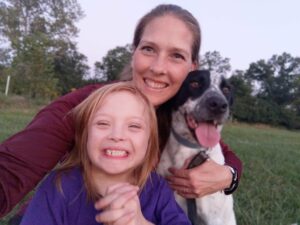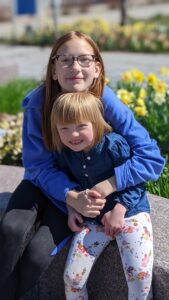October 7, 2021
From mom of four to Down syndrome researcher. Research Spotlight sat with Nicole White and discussed some of the challenges that prevent parents and caregivers from getting involved in the research and how the scientific community could address that deficit in information.
 LuMind IDSC: Tell us a little more about yourself:
LuMind IDSC: Tell us a little more about yourself:
Nicole White: In my day job I’m the director of operations at Cincinnati Children’s Hospital, my other job is going to school full time and working towards my PhD in Leadership and Change Management. I’m also working on my dissertation; I focus on the facilitation of healthcare on people with Down syndrome. If all goes well, I will be graduating with my PhD in six weeks.
LuMind IDSC: How did you become interested in Down syndrome research?
Nicole White: I have four kids, the oldest is 17 and has autism, the second is 15, and the third is 11. My youngest child, Kate, is 6 years old. She’s in first grade, and she has Down syndrome.
When Kate was born, I had three big questions for the doctors:
- How many people with Down syndrome have run a marathon? Because I’m also a runner.
- How much research is currently being done on Down syndrome? Because my oldest son has autism, I was already vested in that world, researching what kind of supports and services to get in place to help him be independent and successful. I thought, “I know what to do, I’ve done this” but my major concern was that I knew Down syndrome but only as a genetic diagnosis that I read in a book, I knew nothing about the everyday life and that was the scariest part. But six years later this turned out to be one of the best parts, just learning to live life around Kate and what she sees and enjoys through a new perspective. Having four children has given me the opportunity as a parent to see life four different ways because they are very different, and it’s exciting to see how they all have different likes, dislikes, and talents and how they are successful in their own ways.
- My third question was: “How much funding is there for Down syndrome?”
LuMind IDSC: What did you find out about research and funding for Down syndrome?
Nicole White: After learning what I could about Down syndrome research (which was limited), I learned that funding was also limited. As a research administrator I knew what the current funding levels were, the current mechanisms, and I quickly realized that they are very low compared to Autism and some other conditions.
LuMind IDSC: When did you decide to roll up your sleeves and get involved?
Nicole White: After we got through the first year of Kate’s life, we had to navigate her immediate medical needs since she had a couple of hurdles we had to get over. One day I was sitting at my desk, and I decided it was time for me to go back to grad school. I picked a program that was adult learning friendly, but I also wanted to pick a topic that could help benefit the outcomes of Down syndrome and healthcare. I was really focused on “how can I make the lives of people with Down syndrome better?” because I knew that it was needed based on the research that I had read.
LuMind IDSC: How did you start your relationship with LuMind IDSC?
Nicole White: In the process of getting my PhD, I started to connect with a few Down syndrome advocacy agencies and nonprofits. One of my projects was a case study; I wanted to work on something that could be impactful and reach the community. I was interested in the gaps in research in Down syndrome. Why is there no more research in Down syndrome and what are the barriers for parents to become more engaged in research? I wanted to find out what were the differences between what is being done versus what parents want to see done. One of the nonprofits that I came across was LuMind RDS, years before the merger with IDSC. I just picked up the phone and started a conversation with Hampus, LuMind IDSC’s CEO. Hampus and his Team went on to edit and help design the survey and then distributed it to the LuMind IDSC community.
The third collaborator was a colleague at Cincinnati Children’s, Anna Esbensen, PhD who had survey design experience. She helped design the survey and made sure that the questions were formatted in a way that the parents and caregivers could understand them.
 LuMind IDSC: What were some striking results you discovered from the survey?
LuMind IDSC: What were some striking results you discovered from the survey?
Nicole White: We found that there were gaps in what is being done in research and what parents wanted to see. Some of those deviations were the social aspects of care such as behavioral management and identifying means for more social supports that are currently not being done. When we looked at medical therapies and treatments (interventions such as drugs or injections etc.) parents expressed strong interest in seeing those kinds of treatments. But we also found out that it’s hard for the researchers to get parents to participate in those types of interventions. There is a lot of hesitancy from parents who are not as eager to participate in more invasive clinical trials. Parents of course were more willing to participate in nonintervention type studies such as surveys, wearing a device, or tests that didn’t pierce the skin or drew blood.
LuMind IDSC: What are some of the current challenges for researchers for recruiting clinical trial subjects?
Nicole White: Parents always have the right to ask questions about a research study. The challenge we found was that sometimes they don’t know what those questions are, but they know that they have questions. They just don’t know how to ask them.
LuMind IDSC: How can researchers better inform the community about the value of their research?
Nicole White: As researchers we need to do a better job, especially when recruiting people on trials, to educate them, so they know which questions to ask. This means sharing information, sharing the background of the study, the purpose of the model. What is it going to impact? How does this work? Etc. There’s a lot of research that happens before we even get to the point of doing trials that parents are not familiar with. Most testing starts at the bench, in a Petri dish on the cellular level.
Our institutional review boards and IRB committees are there for a purpose, they are there to make sure that the subjects of any trial or study are protected. The outcomes of their participation are made known, that we are to remain transparent and ethical about what is going to happen. They watch over with scrutiny and rigor. Families who are not familiar with research process need to know and the rigor that goes into the safety of everyone. As researchers we need to educate the public about those processes.
LuMind IDSC: How should parents and caregivers inform themselves?
Nicole White: A lot of the information that parents get is from Google, though it’s not necessarily a wrong place, there is a need for people to verify that what they are reading is accurate and reputable and that it has good sources.
For instance, in our case, after reviewing the survey, there were so many findings that we thought we should make it into a publication and share it with the community. After three submissions and reviews, the results from the survey are now published.
There’s a reason why we submit articles and findings in research to journals like that, it’s because it goes through the peer review process. They are there to scrutinize and criticize and question everything that we are about to publish in our study. It’s another pair of eyes.
Interested in finding more ways to get involved? Join myDSC for a wealth of resources and read more about exciting advances in the scientific world here!
At the end of October, Nicole White will defend her dissertation. On behalf of LuMind IDSC, congratulations Dr. White!
